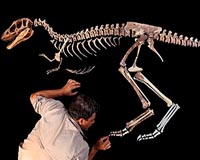| . |  |
. |
New Orleans (UPI) Sep 22, 2009 A giant squid has been netted in the Gulf of Mexico, the first of its kind to be landed in 55 years, scientists say. U.S. government scientists caught the 20-foot-long, 103-pound giant squid while trawling 1,500 feet down, the Houston Chronicle reported. "This was beyond everyone's expectations," said Deborah Epperson, a U.S. Minerals Management Service biologist. The recent catch, off the Louisiana coast, marks the first giant squid found in the gulf since a dead one turned up on the surface in 1954. The latest catch had been alive but died as it was being brought to the surface because the squid cannot survive such quick changes in water depth. The scientists had been trawling in the waters as part of an effort to identify the types of fish and squid sperm whales feed on. The giant squid has been sent to the Smithsonian Institution National Museum of Natural History, where scientists will study it, The (New Orleans) Times-Picayune reported. Giant squid can grow as long as 40 feet. Much about them remains a mystery to scientists, who don't know whether the Gulf catch is a full-grown adult. The giant squid feed on other species of squid and smaller fish, scientists believe. The giant squid has only one known predator, the sperm whale. Share This Article With Planet Earth
Related Links Darwin Today At TerraDaily.com
 New dinosaur find changes views on T. rex
New dinosaur find changes views on T. rexChicago (UPI) Sep 18, 2009 The discovery of a smaller precursor to Tyrannosaurus Rex has changed the way scientists view the evolution of T. Rex, paleontologists said. Scientists now are re-thinking the orthodoxy that T. Rex's distinctive characteristics -- huge head, strong jaws and truncated forelimbs -- signified a necessarily gigantic dinosaur, The Washington Post reported Thursday. T. Rex was 43 feet ... read more |
|
| The content herein, unless otherwise known to be public domain, are Copyright 1995-2009 - SpaceDaily. AFP and UPI Wire Stories are copyright Agence France-Presse and United Press International. ESA Portal Reports are copyright European Space Agency. All NASA sourced material is public domain. Additional copyrights may apply in whole or part to other bona fide parties. Advertising does not imply endorsement,agreement or approval of any opinions, statements or information provided by SpaceDaily on any Web page published or hosted by SpaceDaily. Privacy Statement |